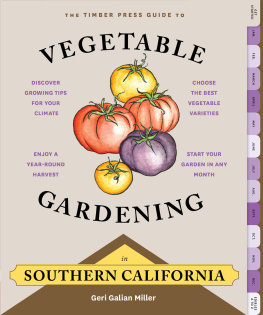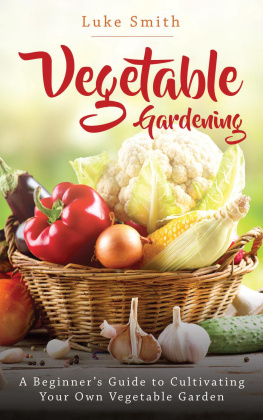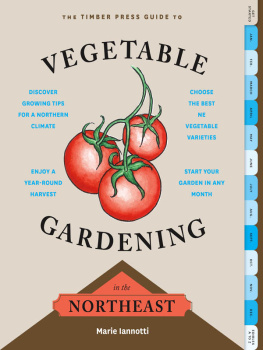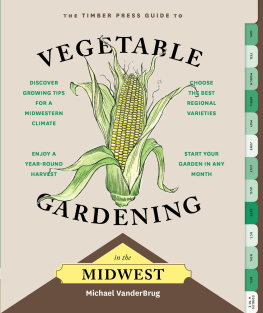
THE TIMBER PRESS GUIDE TO VEGETABLE GARDENING

in
SOUTHERN CALIFORNIA
GERI GALIAN MILLER
Timber Press
Portland, Oregon
Copyright 2015 by Geri Galian Miller.
All rights reserved.
Chapter opener illustrations and illustrations on pages 12 and 31 by Julianna Johnson.
Illustration on page 18 by Scott Westgard. Illustration on page 29 by Skye McNeill.
All other illustrations Julia Sadler
Published in 2015 by Timber Press, Inc.
The Haseltine Building
133 S.W. Second Avenue, Suite 450
Portland, Oregon 97204-3527
timberpress.com
Book design by Kate Giambrone and Julianna Johnson
Cover design by Bree Goodrow
Library of Congress Cataloging-in-Publication Data
Miller, Geri Galian.
The Timber Press guide to vegetable gardening in Southern California/Geri Galian Miller.First edition.
pages cm
Other title: Guide to vegetable gardening in Southern California
Includes index.
ISBN 978-1-60469-757-5
1. Vegetable gardeningCalifornia, Southern. I. Title. II. Title: Guide to vegetable gardening in Southern California.
SB321.5.C2M55 2015
635.097949dc23
2015013387
A catalog record for this book is also available from the British Library.
TABLE OF
CONTENTS
Preface
If youre reading this book, youve been blessed to live in the southern part of the Golden State. As diverse a map of topography as it is a map of humanity, Southern California provides vastly different gardening experiences for all 16.5 million of us (thats 43% of the population of the entire state). From the beautiful inland valleys, with their blistering summer heat and potential winter frosts, to the glorious coastal plains, where temperatures rarely reach the extremes of the thermometer, we relish gardening here in USDA zones 9 to 11, and all the as and bs in between. This book will cover our territory and its various growing regions, starting with the Pacific Coast north of Santa Barbara, at San Luis Obispo, east to just south of Bakersfield, then along the San Gabriel Mountains to San Bernardino and south into San Diego.
Yes, SoCal has it all. Sun and surf, heat and freezes, wind, snow andwell, just a little rain thrown in here and there. Most wonderful of all, though, is that most of us can grow something edible in our gardens 365 glorious days a year! This isnt to say that this near gardening nirvana isnt without its challenges, however. We gardeners still need to develop skills beyond composting. We need to learn how to take our cues from the increasingly unpredictable seasonal shifts that occur here, and be ready to anticipate and deal with the impact of drought and periodic heavy rain on the way we grow food. And what food it is! Our cultural diversity allows us each to share the uniquely personal experience of growing what was familiar to us and our parents and grandparents with our neighbors or fellow community gardeners, and vice versa. It is no surprise then that edible gardens bring people together around food.
Whether you are brand new to gardening or just in need of a refresher, the format of this book makes it easy for you to learn about our unique SoCal growing region, and how climate zones, topography, and changing weather patterns affect our gardening experiences. Included are a primer on the basic tenets of organic gardening, with tips and tricks about planning and planting; a month-to-month guide that delivers practical advice about what you can expectand doeach month; and, the heart of the matter, Edibles A to Z. A seasoned gardeners mantra is know what you grow. The Edibles A to Z section gives you everything youll need to know to successfully grow your tried-and-true favorites and a few new ones that will surprise you! Agretti, dragonfruit, or fenugreek, anyone?
Food security, economic pressures, self-sufficiency, healthier eating, tastier eating, reducing your carbon footprint, family togetherness, community spirit, exercise, stress relief, a landscape that is both beautiful and productivewhatever your reason for choosing to begin your edible gardening adventure, youve joined an incredible group of like-minded folks! Natural nurturers, we edible gardeners support each others desire to grow what we eat and understand each trial and victory along the way.
But first, a few words on success and failure. Above all, remove any preconceived notions you have of both words, especially when youre a beginner. You know, sometimes we just cant seem to get out of our own way. If you have expectations that your first season gardening or your first season in a new site is going to end in some kind of coffee table book garden of Eden, you will be setting yourself up for disappointment. Not only is gardening on-the-job training, but gardening forces us instant-gratification-loving humans to slow down and learn on Mother Natures timetable, not our own. We learn by reading and discussing with other gardeners, of course, but nothing is a substitute for being out there, observing closely, and getting dirty in your own gardenseason after season.
As for failures, when we were children we really had no fear. As we grew, we developed a fear of peer disapproval if we didnt get things right the first time and soon we began to be afraid of trying new things. How sad is that? I have to quote my dear ol dad, who taught me that if you dont fail, you dont learn. So, set your fears aside, follow your bliss, and take that first step or shovelful. Were all learning together. And whatever your reason for getting your hands dirty, this book will become your indispensable, dirt-stained, dog-eared guide and inspiration to get growing all year long!

GET STARTED


WELCOME TO NIRVANA

Yes, we are golden, with virtually endless growing seasons. But we live in a land of contrasts and, increasingly, surprises. This short chapter will give you some idea of the typical climate rhythms of the coastal plains and inland valleys that make up the majority of southern California (then well spend the rest of the book looking into how best to cope when they are anything but typical). Using your areas first and last frost dates and the average high and low temperatures as represented by the USDA Plant Hardiness Zone Map (see Resources for the link) may be helpful as a baseline. But more and more, these should be taken, at best, as a very general guideline rather than a solid predictor of temperature highs and lows for your area (down to the zip code), given the changes in climate weve experienced firsthand over the last decade. All seasoned gardeners have been witness to this change and will attest to the necessity of developing skills to evaluate and assess conditions as they happen.

Next page













